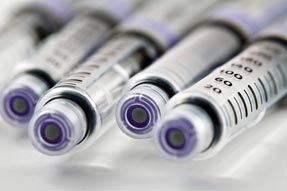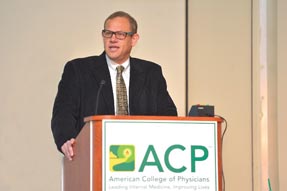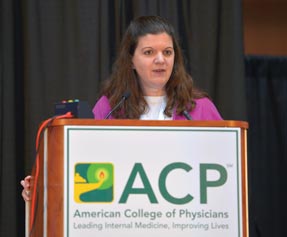Keys to taking a neurological history
The most powerful tool in neurology is the history and physical exam, including the requirement that patients walk in the presence of neurologists, in order to better understand symptoms.
Neurology and internal medicine residents spend increasingly less time involved in treating each other's patients, leading both fields to become less familiar with one another, said Martin A. Samuels, MD, MACP, adding that the lack of familiarity does not benefit patient care.
“I came from internal medicine into neurology,” he recalled during the “Neurology for the Internist” pre-course at Internal Medicine Meeting 2016. “This is now an old-fashioned way to become a neurologist.”

Today, most neurology residents have had 1 year of internal medicine training, some of which was likely spent in ambulatory neurology settings, while students in internal medicine programs spend less time in neurology training due to duty-hour requirements, said Dr. Samuels, a professor of neurology at Harvard Medical School and Brigham and Women's Hospital in Boston. Advances in neurology have contributed to the need for separate training programs just to keep up with the basic science.
Just as internists might feel uncomfortable with neurology, frightened off by their lack of familiarity with the nervous system, the reverse is also true, said Dr. Samuels. At recent American Academy of Neurology meetings, he noted, neurologists who have become progressively more uncomfortable dealing with heart failure and hypertension sought out courses to better manage these conditions in their patients. To help close this gap from internists' side, Dr. Samuels reviewed the workup of patients with neurological symptoms.
The most powerful tool in neurology, he said, is the history and physical exam. “Without it, you're going to continue to have a lot of difficulty in understanding these patients with neurological complaints,” he noted.
The neurological exam is the same the world over, Dr. Samuels said, and involves the following touchstones: psychiatric mental status, neurological mental status, cranial nerve status, a motor exam, a sensory exam, coordination and gait, and reflexes. “They do not have to be done in this order, and often are not done in this order,” he said. “That depends upon cooperation and time. ... It would be wasteful in many respects to try to do a complete examination in every patient.”
Psychiatric mental status
There are 3 components of assessing a patient's psychiatric mental status, regardless of what is wrong with the patient, Dr. Samuels said: affect, mood, and thought.
Affect is the outward appearance of feeling. Does the patient looks frightened, sad, or worried, for example? Mood reflects the patient's internal feelings about his or her emotional state. Thought is the code that a person uses to communicate internally.
“Thought has 2 components: What are you thinking about, and what is the process?” Dr. Samuels said. “Are the thoughts connected in a logical way, yes or no? Does the person make sense? You should understand their story. A is connected to B, to C, to D. If not, always consider that something is wrong with the patient's thought process.”
Neurological mental status
The neurological mental status exam has 4 components: level of consciousness, language, memory, and visio-spatial skills.
Consciousness is a measure of wakefulness and alertness and where the patient is on that spectrum. Attentiveness is the ability to maintain a coherent stream of thought or action, and Dr. Samuels said that abnormalities in this area are the most common neurological abnormalities seen in a general internist's office. The most commonly performed test for inattentiveness is the Mini-Mental State Examination, which is useful but not detailed enough to transmit the texture of the patient's mental status.
Instead, Dr. Samuels conducts the digit span test, a subset of the Mini-Mental State Exam. How many numbers delivered randomly, at 1 per second, can the patient remember forward and backward? The correct answer is about 7 forward and 5 backward. Another test is the Go-No Go protocol. It involves having the patient repeat tapping. Instruct the patient that, when you tap once, he or she should tap twice. When you tap twice, the patient shouldn't tap.
The second component of the neurological mental status exam is language. Unlike thought, the internal code, language is the code one person uses to communicate with another, whether it is via speech, writing, or sign language, Dr. Samuels said.
Is the language fluent, can the patient comprehend normally, and can he or she repeat what you've said? “If you know those 3 aspects of speech, you are practically an aphasiologist. That's all there is to it,” Dr. Samuels said.
The third component, memory, involves 4 aspects: episodic, semantic, working, and procedural. Episodic memory is the kind susceptible to Alzheimer's disease, Wernicke encephalopathy, or herpes simplex encephalitis. It is a memory that occurs in time; patients know when that memory was acquired and how long it has been kept in mind.
It's easy to test, Dr. Samuels said. Tell a short story, or name 3 objects, and have the patient recite what you've said back to you 5 minutes later.
Semantic memories spread from the Papez circuit and are stored all over the brain, Dr. Samuels said. For example, he pointed out, George Washington was the first president of the United States, but no one can remember where they learned that.
Working memory is the ability to remember 7 objects in a row, such as a phone number. Finally procedural memory, often called “muscle memory,” is cerebellar memory, such as that involved in driving a stick-shift car, tying a necktie, or riding a bicycle. “These can be left when the cerebral cortex is severely damaged,” Dr. Samuels said. Pavlovian conditioning is another form of memory, but it is not routinely tested as part of the neurological examination, he said.
Cranial nerves
Dr. Samuels offered pearls for examining the cranial nerves. “Don't just write down ‘II through XII intact.’ What do you have against the first cranial nerve, anyway?” he said. Testing the first cranial nerve, olfaction, is essential to screening for degenerative processes such as Parkinson's disease and for screening a patient who has experienced head trauma or reported taste or smell disorder. It's easy to test just by producing coffee or toothpaste and seeing if the patient can taste or smell it.
The second cluster of nerves, cranial nerves II, III, IV, VI, and VIII, involves the eyes. “Test those and find them normal, and you have exonerated an enormous part of the brain stem,” he said. An easy way to do this involves looking directly at the second cranial nerve using an ophthalmoscope. “It's the only part of the central nervous system that you're going to see in your life, unless you're a neurosurgeon,” Dr. Samuels said. He advised physicians to teach themselves to see the venous pulsations, so when they can't see them, they know something's abnormal, such as increased intracranial pressure. Look at the edges of the optic disc, and take a mental picture of the fundus, he said.
Dr. Samuels advised against writing down “PERRLA” (pupils equal, round, and reactive to light and accommodation) in the medical record. “Most people who write PERRLA haven't done any of those things,” he said. “Write instead, ‘The pupils are 4 mm. They react to light: direct, consensual, and near.’ ... That would be very helpful to people who read the record.”
Examine the eye in dim versus bright light to determine how the pupils react, Dr. Samuels said. If the difference between the size of the pupils increases in bright light, then the small pupil is the abnormal one, indicating a sympathetic nervous system lesion (Horner syndrome). The reverse is true in parasympathetic lesion. Then have the patient look up, right, left, and down to test saccades and pursuit. “Don't go to extremes,” he said. “If you go to extremes, everybody has some nystagmus. That's a false positive.”
The fifth cranial nerve controls facial sensations, and the seventh controls facial motor movement. A test that connects the 2 is the corneal reflex. Test it directly and consensually and compare the results to assess facial weakness versus facial sensation, Dr. Samuels advised.
The eighth cranial nerve is tested by rubbing fingers near the ear and moving them outward to see how acutely the patient can hear. A doctor can also assess air and bone conduction with a tuning fork and compare them to determine whether there is fluid in the middle ear, for example.
The cluster of lower cranial nerves—IX, X, and XII—involves the palate and the tongue. Long before a doctor might see anything wrong, dysphagia, nasal speech, or a pseudobulbar affect could signal the presence of amyotrophic lateral sclerosis, Dr. Samuels noted.
Finally, assess the eleventh cranial nerve by asking patients to turn their heads or shrug their shoulders. “Don't push hard, especially in frail older people,” he said. “In general, having the person do natural functions is better than pushing and pulling against resistance.”
Motor exam
The motor exam assesses muscular power, tone, and bulk. When assessing power, look for patterns of weakness or asymmetry when moving the limb passively, Dr. Samuels recommended. Spasticity is a velocity-related stiffness, compared to lead-pipe stiffness, in which a limb is hard to move at all. Hypotonicity is hard to recognize in adults, Dr. Samuels pointed out.
Muscle bulk is also hard to assess, especially in muscles that are big and have a lot of fat in them. Dr. Samuels said he might instead look at small muscles of the hand, for example, to more easily see if there's really atrophy or just loss of fat.
Sensory exam
The sensory exam is the most difficult part of the neurological exam because there are very few objective tests available, Dr. Samuels said. Patients have to be astute observers to provide useful data, so do not expect too much from them. For example, when you ask the person to touch both sides of the face, and there's a slight difference in sensation, that doesn't necessarily indicate a problem, he said.
Coordination and gait
Observing a patient walking is one of the most useful neurological exams, Dr. Samuels said. “Everyone who can walk must walk in the presence of the neurologist. It's one of the most useful of all of our tests. If you could just take a history and have people walk, you could make 90% of the diagnoses with just that alone,” he noted.
In patients who cannot walk, there are surrogate tests, such as the finger-to-nose test. “And don't take off too many points for normal age. That's where mistakes are made,” he said. “Not until age 80 do I take off any points for age alone. Don't attribute too much to aging, or you are going to miss disease.”
Reflexes
There are 4 kinds of reflexes: proprioceptive, nociceptive, anti-gravity, and release. These are useful because they don't require any cooperation at all, such as in comatose patients, for example, Dr. Samuels said. The downside is that reflexes aren't available for every single neurological function.
Dr. Samuels offered a pearl for addressing the proprioceptive reflexes, which involve how the body knows where something is in space at any single time, by assessing whether muscles are contracted and how much. The 5 proprioceptive reflexes are the biceps, triceps, and brachioradialis in the forearm in the upper extremities and the knee jerk and ankle jerk in the lower extremities.
Dr. Samuels said he always carries his Babinski hammer with him because he never knows when it might be needed. He applies a finger to the tendons for the biceps, triceps, and forearms, then strikes his finger to assess the muscle and avoid directly striking it. But it's OK to hit directly onto the tendons for knees and ankles because the muscles are so far away from their tendons in the lower extremities, he said.
Dr. Samuels advised physicians to grade reflexes on scale of 0 to 4. A grade of 0 is scored when there is no reflex. A grade of 1 is scored when extra effort is needed, such as when the Jendrassik maneuver is required to elicit a patellar reflex. A score of 2 is normal, with 1 reflexive jerk per tap, and a score of 3 signals an increased reflexive reaction. A 4 means there is more than 1 jerk per tap. He cautioned his audience not to add pluses and minuses to scores or to write down “trace” reflexes, because neither of these details adds any neurological insight to the medical record.
He also advised against relying on medical records and other doctor's viewpoints, recounting a colleague's visit note he recently reviewed. Unfortunately, the note was for a patient no-show visit. “It was a huge long note,” he said. “If you had put it on regular paper, it would have been 8 pages, single-spaced, looking very impressive. The only thing missing was the only thing that's important, which is what the doctor thinks the patient had.”





